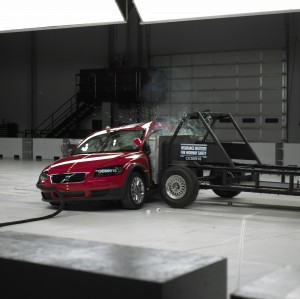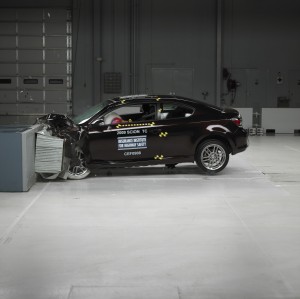
Volvo, a company that markets safety, obtained the same rating as Ford -- even though C30 is built on an updated version of the Focus platform.
The Insurance Institute for Highway Safety has just released the latest results from its ongoing safety tests, which exceed the standards imposed by the U.S. government. In the latest side-impact tests, five 2009 coupes were crunched, including the Chevrolet Cobalt, Ford Focus, Honda Civic, and Scion tC, small models all, although technically the Volvo C30 is rated as a mid-size car.
In the Institute’s side impact test, the C30 and Focus are rated good in results, which simulate an SUV hitting the side of a car at 31 mph. What’s interesting about the Volvo and Ford ratings is the Ford obtained the same “good” as the Volvo, even though it is built from an older version of a shared platform. It is just one example of the challenges Volvo faces maintaining its long-standing reputation for safety as all makers continue to improve their performance in the tests. And the good here does not allow for further distinctions.
The Civic, Cobalt, and tC models are rated a notch down at “acceptable.” Caveat: the Cobalt’s rating applies to vehicles built after May 2009, when General Motors modified its curtain airbags.
It is the side airbags that appear key to the positive results, as all of these cars had side airbags. In 2003, facing federal regulation, automakers promised to voluntarily put side airbags in their vehicles as standard equipment by the 2010 model year.
The Institute rates vehicles good, acceptable, marginal, or poor based on performance in front- and side-crash tests. The third, rear-impact test, measures how well vehicle seats and head restraints protect people against neck injury in low-speed rear crashes.
Side impacts are the second most common type of fatal crash. More than 8,000 people were killed in side impacts in 2007. This compares with more than 14,000 deaths in frontal crashes.
Side evaluations are based on performance in a crash test in which the side of a vehicle is struck by a barrier moving at 31 mph. The barrier represents the front end of a pickup or SUV. Ratings reflect injury measures recorded on two instrumented SID-IIs dummies, assessment of head protection countermeasures, and the vehicle’s structural performance during the impact.
The Institute also conducted front and rear tests on the same two-door models.
“We’re often asked about the crash test performance of 2-door cars,” says David Zuby, Institute senior vice president for vehicle research. “Design and structural differences mean we can’t automatically apply our test results of 4-door cars to 2-door versions of the same models. We decided to do these tests to see how the 2-doors stack up in protecting people in the three most common kinds of crashes.”

The Institute said the tC's structure held up well, but overall performance wasn't as good as the other cars, since the driver would have been injured.
“Overall the results for 2-door cars are good news,” Zuby says. “All but one earn good ratings in our frontal offset test. Only 2 of the 5 earn this rating for protection in side crashes, but none of the 5 earns anything less than an acceptable rating. This is pretty good, considering how demanding the side test is. It simulates being struck by a pickup or SUV.”
Among the 5 cars, 4 earned the top rating of good in the 40 mph frontal offset test. The Scion tC is rated acceptable.
The Institute said the tC’s structure held up well, but overall performance wasn’t as good as the other cars. Forces recorded on the driver dummy indicate that an injury to the lower right leg would be possible, and a high head acceleration occurred when the dummy’s head bottomed out the airbag.
The tC is unique in this group for having a separate airbag in the lower instrument panel designed to minimize knee injuries in frontal crashes.
Occupant protection in simulated rear-ender collisions has mostly “lagged” behind improvements in front and side crashworthiness, in the Institute’s opinion, but the recently tested cars are getting better. All but the tC earn good or acceptable rear crash ratings. Neck sprain or strain is the most frequently reported crash injury in U.S. insurance claims according to the Institute, which is funded by insurance companies.

